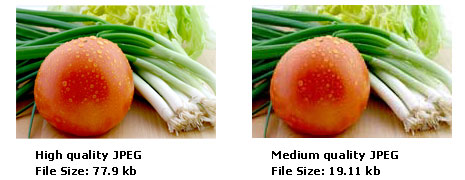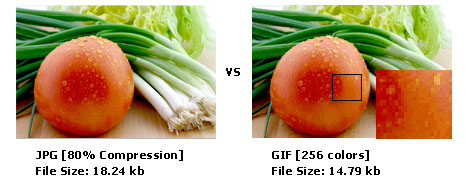There are a few image file formats that rule the Internet, allowing for various types of images to be stored and transmitted online in a most authentic way by means of compression.
JPEG - image compression for photographic images
JPEG is an abbreviated form of Joint Photographic Experts Group, the independent committee that created it as a standard for photography compression, which was approved in 1994 as ISO 10918-1. The JPEG standard refers to both the technique for compressing an image into a stream of bytes and then decompressing it back close to its original form, and the file format holding that stream.
The JPEG image file format has become popular for offering an amazingly effective compression method for color images. It helps images to be compressed to about five percent of their original size, which allows for minimized traffic consumption for websites using JPEG images. The complex compression algorithm allows the customers to create smaller graphics by losing some of the quality of the image. Although this is known to be a lossy compression, meaning that some image details are lost while the image is being compressed, any quality changes are usually invisible to the human eye.
An example of an image compression using the JPEG image format

Generally, you can control the compression quality results by choosing from a range of compression algorithms when creating a JPEG file or converting an image from another format to JPEG. The resulting quality of a JPEG image after decompression is proportional to its size, so, the bigger you choose it to be, the more preserved its original properties will remain.
The JPEG compression standard also supports a separate lossless mode. However, it has not managed to replace the lossy mode since it does not provide the same maximum levels of compression and hence - optimum image size decrease.
Thanks to its effective compression technique, JPEG is most widely used for storing and transmitting full color and grey-scale digital images and paintings that represent scenes from the real world with eye-pleasing smooth tone variations.
JPEG - quality images for your website
As we already mentioned in this article, JPEG is one of the image formats responsible mainly for reproducing color photography images. This makes it the format that best represents the real world on the web, outmatching in this regard its counterparts - GIF and PNG.
An example of a comparison between JPEG and GIF image compression

In contrast to the other image file formats widely spread on the web - GIF and PNG, JPEG is not as well suitable for displaying non-realistic color-limited images such as line drawings or animated graphics, featuring well-defined edges of the presented objects. The lossy compression standard it supports also makes it unsuitable for storing images that will be edited repeatedly, due to the expected quality decrease each time an image is decompressed. It is also not recommended for storing astronomical or medical images where an accent on the exact data reproduction is placed.
To better understand the main quality/size disadvantages of the JPEG format as far as images with color-limited and solid-color areas are concerned, please check the video example in the GIF image format article.
Also, if you want to see how the JPEG format is compared to other popular image formats when we have a photo image, please check the video example below:
How to compress photos and full-color images for your website (movie)
JPEG supports several image file formats. The most commonly employed of them are JPEG/Exif, used by most photographic image capture devices, such as digital cameras, and most image editing programs, and JPEG/JFIF. Both formats are known for allowing photographic images to be stored and quickly transmitted over the Internet and are most commonly referred to as simply JPEG.
The images stored in a JPEG format could have one of the following file extensions: .JPG, .JPEG, .JFIF, .JIF .or .JPE.